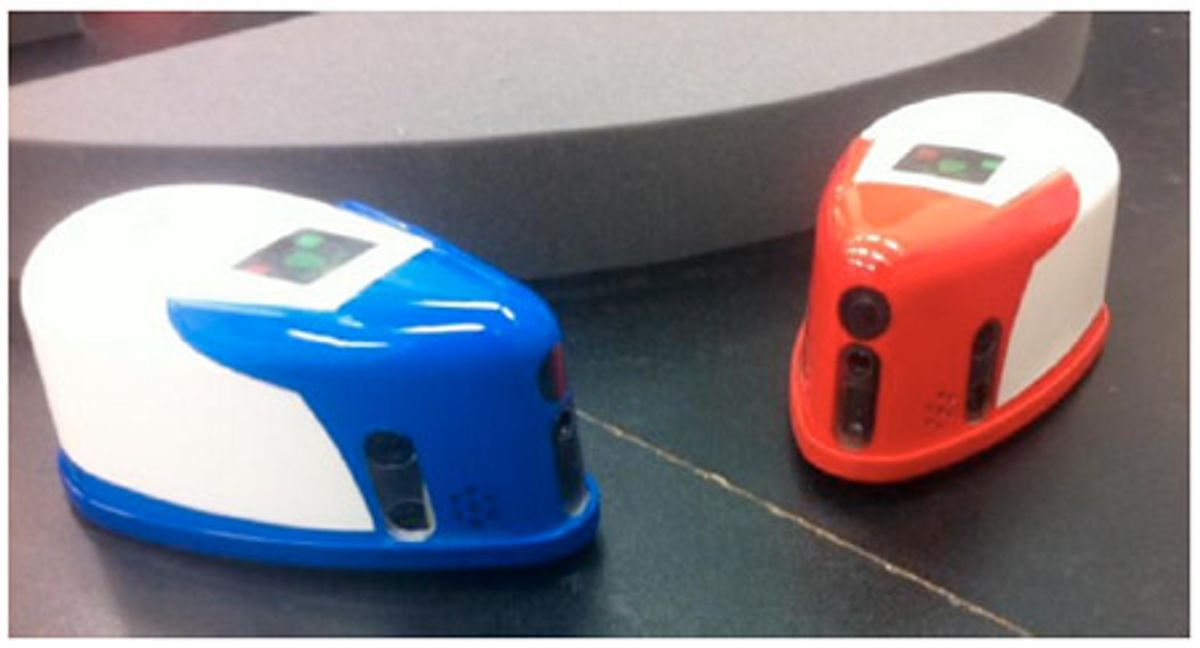Last year, we were introduced to Lingodroids, which are small robots capable of developing their own language. This isn't a computer language, but more of a human language, with words that we humans could speak if we wanted to. These words have been invented by the robots themselves, using a variety of games to establish correlations between specific words and places, directions, and distances. And last week, Scott Heath from the University of Queensland in Australia presented a new paper on how the Lingodroids have been teaching themselves brand new words for different lengths of time.
Space and time are important concepts for robots and humans alike, since they're the four dimensions that define most of our existence. So when robots want to meet, it's not enough to simply decide on where to meet, they also have to decide when to meet.
Last year, we learned how the Lingodroids were able to use interactive games to establish words for places, directions, and distances. For details, read our article from May of 2011, but basically the robots randomly generate names for unfamiliar areas, and then share these names with each other every time they meet, using games to reinforce associations and define boundaries. By extrapolating on this method, the Lingodroids can also develop terms for directions and distances, and cooperatively create maps of places that they've never been to. From last year's paper, here are the location maps and and distance and direction terms developed from scratch by two Lingodroids:
So for example, using the above lexicon, two Lingodroids located at "jaya" (in the center of the map) have defined the location "mira" (which they can't actually visit) by agreeing that it's at "puga puru" (northwest a long distance).
The method for inventing new words to describe time is fundamentally similar to how the robots agree on words to describe locations and directions and distances: through conversational games. For example, the robots played a game called "how-long-since-we-met," where they'd randomly explore the maze and give names to the amount of time since they last met. This established a basic lexicon, which the robots would reinforce with other games, like "meet-at," where the robots would choose a place and time to, you know, meet.
The graph below shows the duration lexicons that the two robots developed; the x-axis is time (in seconds) and the y-axis is a measure of the individual robot's confidence in that particular word/duration association:
By combining these two lexicons, the Lingodroids can have relatively complex spatial and temporal goal-oriented conversations, like "ropi huzu jaya fohu," which would mean something like "let's meet just a little bit north of the 'jaya' location about 35 seconds from now."
Over the last year, the researchers upgraded the robot hardware to little iRats (pictured at the top of this post), and their environment is now a maze shaped like an intertwined "U" and "Q" (for University of Queensland):
Next, the researchers plan to start working on more conceptual units of time that humans tend to use based on context, like "soon" and "later." Also, humans like to assign words to specific points in time like "noon," which is tricky because these words can refer to points that will never happen again, as well as points that occur cyclically. The overall idea is that getting robots to understand a full set of spatial and temporal concepts in a more human way will enable them to interact that much more effectively with us in a wide range of contexts, without requiring us all to learn how to speak robot.
Lingodroids: Learning Terms for Time, by Scott Heath, Ruth Schulz, David Ball, and Janet Wiles, was presented last week at the 2012 IEEE International Conference on Robotics and Automation in St. Paul, Minn.
[ Lingodroids ]
Evan Ackerman is a senior editor at IEEE Spectrum. Since 2007, he has written over 6,000 articles on robotics and technology. He has a degree in Martian geology and is excellent at playing bagpipes.







